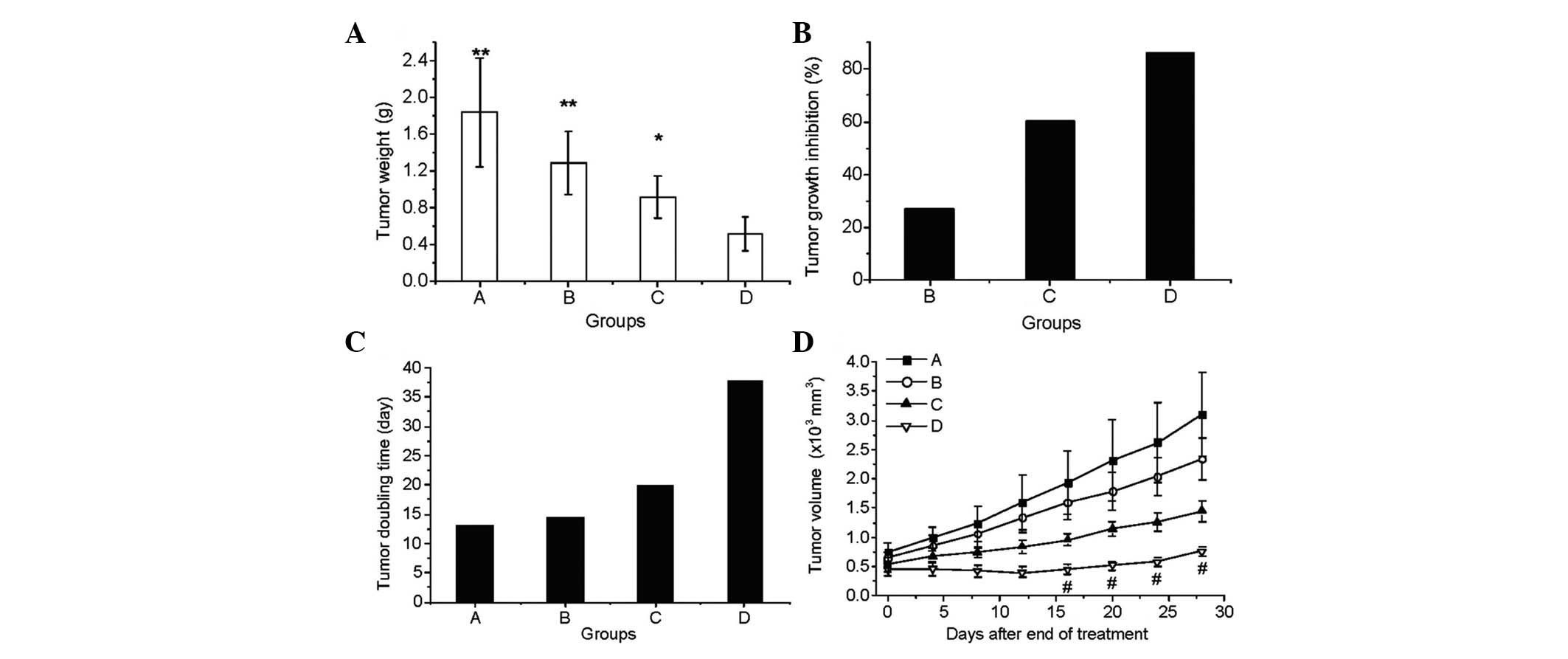Antitumor activity of Endostar combined with radiation against human nasopharyngeal carcinoma in mouse xenograft models
- Authors:
- Juying Zhou
- Lili Wang
- Xiaoting Xu
- Yu Tu
- Songbing Qin
- Yuzhen Yin
-
View Affiliations
Affiliations: Department of Radiation Oncology, The First Affiliated Hospital of Suzhou University, Suzhou, Jiangsu, P.R. China, School of Radiation Medicine and Public Health, Medical College of Soochow University, Suzhou, Jiangsu, P.R. China
- Published online on: August 8, 2012 https://doi.org/10.3892/ol.2012.856
-
Pages:
976-980
Metrics:
Total
Views: 0 (Spandidos Publications: | PMC Statistics:
)
Metrics:
Total PDF Downloads: 0 (Spandidos Publications: | PMC Statistics:
)
This article is mentioned in:
Abstract
Radiation treatment for nasopharyngeal carcinoma (NPC) is common and effective. However, local recurrence occurs frequently. Endostar, a novel recombinant human endostatin, is an antiangiogenic drug with a potent antitumor effect. The present study aimed to observe and explore the radiosensitization effects of Endostar on NPC and its underlying mechanism. The NPC subcutaneous transplantation tumor animal model was established to evaluate the antitumor activity of Endostar combined with radiation (Endostar + radiation) treatment compared with monotherapy (Endostar or radiation). Tumor growth and tumor weight were measured to evaluate the antitumor effect. The level of vascular endothelial growth factor (VEGF) and microvessel density (MVD) were measured using immunohistochemical staining of the tumor tissues. Significant antitumor activity was found in the Endostar + radiation group. The tumor inhibition rates of Endostar, radiation and Endostar + radiation were 27.12, 60.45 and 86.11%, respectively. The VEGF levels in the tumor tissue in the Endostar + radiation group were lower than those in the radiation and control groups. The MVD in the tumor tissues in the Endostar + radiation group was 12.2±2.5, lower than that in the Endostar (29.3±3.4), radiation (23.5±3.6) and control (44.7±5.1) groups. These results suggest that Endostar increases the radiation sensitivity of NPC-transplanted tumors in nude mice by lowering VEGF expression. In this study, the NPC animal model was established, which reflects the efficacy of clinical combination therapies and the combination of Endostar and radiation. The mechanisms of the combination therapies should be further investigated using this model.
View References
|
1.
|
WB YinXZ GuNasopharyngeal
carcinomaRadiation Oncology4th editionPeking Union Medical College
PressBeijing4802007
|
|
2.
|
D KwongJ ShamD ChoyThe effect of
loco-regional control on distant metastastic dissemination in
nasopharyngeal carcinoma: an analysis of 1301 patientsInt J Radiat
Oncol Biol
Phys3010291036199410.1016/0360-3016(94)90306-97961008
|
|
3.
|
AB Langeland MarthinsenA Dybdahl WanderasS
LundgrenT StrickertEffects of growth factors on growth and
radiation sensitivity of the human breast cancer cell line
T-47DOncol Rep9397403200211836616
|
|
4.
|
KE HovingaLJ StalpersC Van
BreeRadiation-enhanced vascular endothelial growth factor (VEGF)
secretion in glioblastoma multiforme cell lines - a clue to
radioresistanceJ
Neurooncol7499103200510.1007/s11060-004-4204-716193379
|
|
5.
|
J FolkmanRole of angiogenesis in tumor
growth and metastasisSemin
Oncol291518200210.1053/sonc.2002.3726312516034
|
|
6.
|
AL FeldmanNP RestifoHR
AlexanderAntiangiogenic gene therapy of cancer utilizing a
recombinant adenovirus to elevate systemic endostatin levels in
miceCancer Res6015031506200010749112
|
|
7.
|
Y LingY YangN LuEndostar, a novel
recombinant human endostatin, exerts antiangiogenic effect via
blocking VEGF-induced tyrosine phosphorylation of KDR/Flk-1 of
endothelial cellsBiochem Biophys Res
Commun3617984200710.1016/j.bbrc.2007.06.155
|
|
8.
|
T MäkitieP SummanenA
TarkkanenMicrovascular density in predicting survival of patients
with choroidal and ciliary body melanomaInvest Ophthalmol Vis
Sci4024712480199910509639
|
|
9.
|
M TokurakuH SatoS MurakamiActivation of
the precursor of gelatinase A/72 kDa type IV collagenase/MMP-2 in
lung carcinomas correlates with the expression of membrane-type
matrix metalloproteinase (MT-MMP) and with lymph node metastasisInt
J Cancer64355359199510.1002/ijc.29106405137591310
|
|
10.
|
A GergerA El-KhoueiryW
ZhangPharmacogenetic angiogenesis profiling for first-line
Bevacizumab plus oxaliplatin-based chemotherapy in patients with
metastatic colorectal cancerClin Cancer
Res1757835792201110.1158/1078-0432.CCR-11-111521791631
|
|
11.
|
J MaCS ChenT BluteDJ
WaxmanAntiangiogenesis enhances intratumoral drug retentionCancer
Res7126752685201110.1158/0008-5472.CAN-10-324221447737
|
|
12.
|
ZX WangSM WangQ ZhouEndostatin in
different administration routes combined with adriamycin
chemotherapy in the treatment of liver cancer xenograft in miceNan
Fang Yi Ke Da Xue Xue Bao30190319052010(In Chinese)
|
|
13.
|
BA TeicherN DupuisT KusomotoAntiangiogenic
agents can increase tumor oxygenation and response to radiation
therapyRad Oncol Invest2269276199410.1002/roi.2970020604
|
|
14.
|
N Hansen-AlgenstaedtBR StollTP PaderaTumor
oxygenation in hormone-dependent tumors during vascular endothelial
growth factor receptor-2 blockade, hormone ablation, and
chemotherapyCancer Res60455645602000
|
|
15.
|
X LuoJM SlaterDS GridleyRadiation and
endostatin gene therapy in a lung carcinoma model: pilot data on
cells and cytokines that affect angiogenesis and immune
statusTechol Cancer Res
Treat5135146200610.1177/15330346060050020716551133
|
|
16.
|
S ItasakaR KomakiRS HerbstEndostatin
improves radioresponse and blocks tumor revascularization after
radiation therapy for A431 xenograft in miceInt J Radiat Oncol Biol
Phys67870878200710.1016/j.ijrobp.2006.10.03017293237
|
|
17.
|
CG LeeM HeijnE di TomasoAnti-vascular
endothelial growth factor treatment augments tumor radiation
response under normoxic or hypoxic conditionCancer
Res6055655570200011034104
|
|
18.
|
A AbdollahiKE LipsonX HanSU5416 and SU6668
attenuate the angiogenic effects of radiation-induced tumor cell
growth factor production and amplify the direct antiendothelial
action of radiation in vitroCancer Res63375537632003
|
|
19.
|
A KaliskiL LassauL
MaggiorellaAntiangiogenic effect and tumor growth control achieved
by an MMP-inhibitor combined to radiation in vivo, targeting
radio-induced MMP-2 enhancement and VEGF modulationInt J Radiat
Oncol Biol Phys60368369200410.1016/j.ijrobp.2004.07.218
|
|
20.
|
Z TopolovecA CorusićD BabićVascular
endothelial growth factor and intratumoral microvessel density as
prognostic factors in endometrial cancerColl
Antropol34447453201020698116
|













